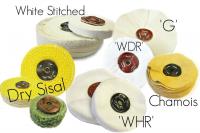 Add My Company
Add My Company
Sign In
How to Choose the Right Polishing Mop
02-04-2015

Choosing the right polishing mop can appear baffling, but with a few pointers it really isn’t so bad.
For the purposes of a ‘quick start’ guide we’ll keep things simple. There are plenty more tips and considerations which we will cover in future blogs.
The key things to consider…
What metal are you polishing? Is it hard or soft?
What compound will you be using? All mops are simply carriers for compound which does the work.
What size will you need? You won’t want a large mop for a small item, if you are using a drill the mops may need to be smaller than if you are using a bench polisher.
The three main types of mop are Dry Sisal, White Stiched Mops and Loosefold Mops.
Dry Sisal Mops are used for the first cut to get a good, flat surface ready for polishing. To get an effective polish, the metal needs to be as flat as it can possibly be without scratches or dings. Dry sisal normally suits harder metals, it can be used on silver but with any soft metal it will remove material quickly something you need to consider if it is a delicate item. It is ideal for Aluminium, Brass, Steel etc. They’re not normally necessary for precious metals i.e jewellery but are used by silversmiths for large items.
Use dry sisal mops with a cutting compound, something like Abracut or Apollo depending on the metal you are polishing. These compounds are coarse and will flatten the metal quickly.
Coloured Sisals are harder/firmer than dry sial mops, the colour denotes the hardness.
White Stitched Mops are the next firmest, they are normally used either as a first cut or after dry sisal mops. They can be used with polishing compound on Stainless Steel for instance but can also be used for cutting with coarse compound such as Abracut and Apollo. They really are an all rounder, they can be used for all metals. Normally still a little hard for precious metals, some people really get on with them so there’s no hard and fast rule.
A really good combination is a white stitched mop and 2000D a one operation bar. It will flatten and then polish any metal type so long as it is reasonably smooth (sanded to around 800g, 1200g would be even better).
Loosefold Mops offer lots of options!
These are used for their flexibility, usually for the latter finishing stages. They vary in hardness depending on the material used.
‘G’ unbleached calico is our most popular choice because it can be used for cutting and polishing. It is very popular with jewellers who often use it for the initial cut with Apollo Tripoli compound. It is a good general purpose mop in the middle in terms of hardness.
‘WFC’ is white and hard, the material stands up like it has been starched. It can be used to make abrasive scurfs with Grainlock and Aloxite grit or a Satene with No3 Glue and Lea Satene Bars. These leave a matt texture finish on metal. It can also be used with cutting compound much like a white stitched bar, it’ll keep edges better than softer mops.WFC
‘WDR’ white double raised is our most popular finishing mop, it is soft and brush free. It can be used with polishing compound as well as clean (with a little Vienna Lime) to clean up after polishing and remove swirls.
‘WHR’ and REFLEX are both very soft. Reflex is the softest in our range. They are often referred to as Swansdown. Both are very well suited to a high finish when used with the right compound. We would recommend Lea FF9 ultimate finishing bar or Menzerna (M5 or P175). Jewellers generally use these mops for their final polishing stage. WHR and Reflex
Chamois Mops are different again. Jewellers often use them with rouge for final polishing, it’s a good traditional option. We make these to order, their high quality and made here in our factory. They are also used for glass polishing.
Choosing a set of Mops to Start With..
Depending on the metals you are working with you’ll need at least two mops and two compounds. A 3 stage process will give a better finish. A dry sisal, G mop and WDR are a good start. It’s best to have a different mop for each compound and also each type of metal. A mop for aluminium, brass etc and a separate one for Steel is important. Again precious metals should have their own mops ideally.
For non ferrous metals i.e aluminium, brass etc Apollo, 2000D and 309BX (or FF9) lea compounds are best. Apollo and 309BX would suffice.
For ferrous metals i.e Steel and Stainless Steel, Abracut, 2000D and FF9 is best.
For Precious Metals, I would go for WFC if you have lots of cutting to do with Apollo, then a G mop with Apollo if there’s less work to do. Finally I’d go for Reflex or WHR with Rouge, FF9 or one of the Menzerna finishing bars.
2000D, 309BX and FF9 are great options because they will work on all metals.
For more information on How to Choose the Right Polishing Mop talk to Polishing Jewellery
Enquire Now
List your company on FindTheNeedle.
